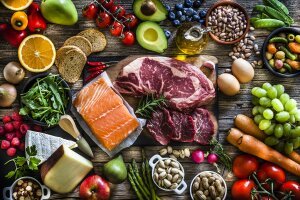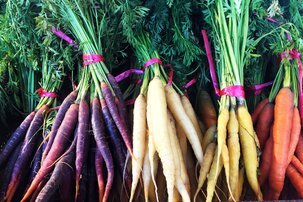The Best Sources for Lean Protein While on a Diet

 A balanced diet requires each of the three macronutrients: carbohydrates, fat and protein, says Amy Kimberlain, a registered dietitian and certified diabetes educator based in Miami who's a spokesperson for the Academy of Nutrition and Dietetics. Whatever diet or eating regimen you're on, protein is essential.
A balanced diet requires each of the three macronutrients: carbohydrates, fat and protein, says Amy Kimberlain, a registered dietitian and certified diabetes educator based in Miami who's a spokesperson for the Academy of Nutrition and Dietetics. Whatever diet or eating regimen you're on, protein is essential.
Food backgrounds: top view of a rustic wooden table filled with different types of food. At the center of the frame is a cutting board with beef steak and a salmon fillet and all around it is a large variety of food like fruits, vegetables, cheese, bread, eggs, legumes, olive oil and nuts. DSRL studio photo taken with Canon EOS 5D Mk II and Canon EF 70-200mm f/2.8L IS II USM Telephoto Zoom Lens
(GETTY IMAGES)
“Protein specifically helps to support many body functions – such as cell maintenance, the building and contraction of muscles and tissue repair,” Kimberlain says. “It helps keep body fluids in balance. Really, any time that our body is growing or repairing itself, we’re in need of protein. Additionally, protein can be helpful in keeping us fuller longer and helping to stabilize blood sugar levels. Obtaining an adequate amount of protein is essential to our overall health.”
[ SEE: 8 High-Protein Breakfasts That Keep You Full. ]
How Much Protein Is Enough?
It's important to keep in mind that the amount of protein an individual needs depends on factors such as their size, age and level of physical activity. The current recommended dietary allowance, or RDA, for adults is 0.8 grams per kilogram of an individual's body mass – or 0.36 grams per pound of body weight). This is the minimum daily intake to prevent a deficiency.
For example, for a man who is between the ages of 25 and 50 and who weighs 174 pounds, the RDA is about 63 grams of protein. He may need more if he's physically active. For a woman in the same age group who weighs about 139 pounds, the RDA would be about 50 grams of protein, which could be higher if she exercises a lot.
For a sedentary person who gets little to no exercise, consuming about 0.8 grams of protein per kilogram of body weight would probably be sufficient, Kimberlain says. For someone who weighs 174 pounds, that translates to about 63 grams of protein. However, if that person is walking 30 minutes a day, five days a week, her or she may benefit by consuming about 79 grams of protein per day; that's one gram of protein per kilogram of weight.
"And if we're talking endurance-type athletes, they'd be up to two grams a day (per kilogram of weight). It all depends on their workouts for the day," Kimberlain adds.
Lean protein is defined by the federal government as protein sources that have less than 10 grams of total fat, including four-and-a-half grams or less of saturated fat, and fewer than 95 milligrams of cholesterol – based on a three-and-a-half ounce serving. “Another way to say this is, a protein source that has two to three grams of fat per ounce,” Kimberlain says.
Keeping the amount of saturated fat and LDL cholesterol (also known as “bad cholesterol”) you consume in check is important to protect your heart health, research suggests. For example, research published in 2020 in the journal Current Opinion in Nephrology Hypertension suggests that taking medications that lower the levels of LDL cholesterol in your blood can reduce the risk of atherosclerotic cardiovascular disease in people with chronic kidney disease.
Some cuts of red meat have some of the highest levels of saturated fat. For instance, a four ounce serving of T-bone steak would have about 5.44 grams of saturated fat. Beef typically contains about 1.36 grams of saturated fat per ounce. But four ounces of roast beef has a mere 1.5 grams of saturated fat.
LDL cholesterol is known as "bad" cholesterol because it collects in the walls of your blood vessels. This buildup can increase the chances of health problems like stroke and heart attacks. Most of the cholesterol in your body LDL, and the rest is high-density lipoprotein, or "good" cholesterol. HDL cholesterol is important because it routes LDL to your liver, which flushes it out of your body.
“Lean proteins are important as part of a healthy diet due to their heart health (properties) and influence on reducing cholesterol and blood pressures,” says Emily Feivor, a registered dietitian at Long Island Jewish Forest Hills, part of Northwell Health in New York.
[ SEE: 7 Top Healthy Protein-Rich Foods. ]
Good Plant-Based Sources of Lean Protein
There are a variety of ways to consume protein from both animal and plant-based foods. Animal protein contains the most protein, says Kayla Kopp, a registered dietitian with Cleveland Clinic’s Center for Human Nutrition. “One ounce of animal protein has about seven grams of protein,” she says. “If you are vegetarian or vegan, it is more difficult to get enough protein – but it is possible through a consumption of plant sources.”
Good plant-based sources of protein include:
Beans. A cup of pinto beans has 15 grams of protein.
Chickpeas. A cup of chickpeas has about 14.5 grams of protein.
Edamame. A cup of edamame has about 18 grams of protein.
Hemp hearts. A cup of hemp hearts has about 10 grams of protein.
Lentils. A cup of lentils has about 18 grams of protein.
Quinoa. A cup of quinoa has about 24 grams of protein.
Tofu. A cup of firm tofu has about 44 grams of protein.
“It’s ideal to stick to lean protein sources rather than protein sources higher in fat,” Kopp says. “Red meat should only be consumed one to two times a week.”
In contrast, high-fat proteins include certain animal proteins high in fat:
Bacon. A slice of bacon contains 3.5 grams of saturated fat.
Ham. A 3-ounce serving of ham contains 2.5 grams of saturated fat.
Hot dogs. A single hot dog contains 5.3 grams of saturated fat.
Pepperoni. An ounce of pepperoni contains 4.2 grams of saturated fat.
[ SEE: Highest Protein Fruits. ]
Good Sources of Lean Protein
At mealtime, it’s a good idea to “keep protein at the top of your mind, to consume at least 20 to 30 grams of protein per meal,” Feivor says. “Ways to make this easy for yourself is to prepare extra portions of chicken, breast, fish or other lean protein, and to keep it stored in the refrigerator to add to meals throughout the week.”
Being mindful about your protein intake can be useful, Kimberlain agrees. “The key is aiming to incorporate protein at every meal, all the while balancing with your carbs and healthy fats,” she says. “(From talking to people), breakfast tends to be the biggest challenge in incorporating lean protein. I love to make my oats with skim milk (which contains protein). As a whole grain, oats also contain protein, so by combining them you get two sources of lean proteins.”
Sources of lean protein include:
Chicken (skinless).
Fish.
Low-fat cottage cheese.
Low-fat Greek yogurt.
Pork (lean cuts).
Salmon.
Skim milk.
Tempeh.
Tofu.
Tuna.
Turkey (white meat).
Lean meats such as roast beef and pork.
Tips for Consuming Foods High in Protein
Good sources of protein at breakfast can include eggs, low-fat milk, turkey sausage, Greek yogurt or a smoothie made with protein powder, Kopp says. When planning lunches and dinners, always try to follow the healthy plate approach by including one cup of vegetables, three to four ounces of protein and one half to one whole cup of whole grains.
Kopp offers these tips to make sure you always have protein on hand, especially if you don’t have a lot of time to cook:
Store cans of tuna in the pantry to use on salads or in wraps.
Keep frozen fish or shrimp in the freezer to quickly thaw and use in a stir-fry or in whole-grain bowls.
Cook one pound of lean ground turkey or beef at a time to store in the refrigerator and reheat for various recipes throughout the week.
Purchase high-protein pasta made out of chickpeas or lentils.
High-Protein Meals and Snacks
Working protein into each meal and snack shouldn’t be too complicated or challenging, Kopp says.
Here is a day’s worth of high-protein meals and a snack:
Breakfast: Scrambled eggs with spinach, a slice of whole wheat toast and a half cup of berries. One egg typically contains six to seven grams of protein.
Lunch: A whole wheat wrap with sliced turkey, low-fat cheese, lettuce, tomato and balsamic vinaigrette. Whole wheat products typically contain more protein than their white flour counterparts. This meal would contain about 35 grams of protein, Kopp says.
Dinner: Chicken brown rice bowl with black beans, sautéed peppers and onions, lettuce and salsa. Try adding a small scoop of plain non-fat Greek yogurt in place of sour cream for even more protein.